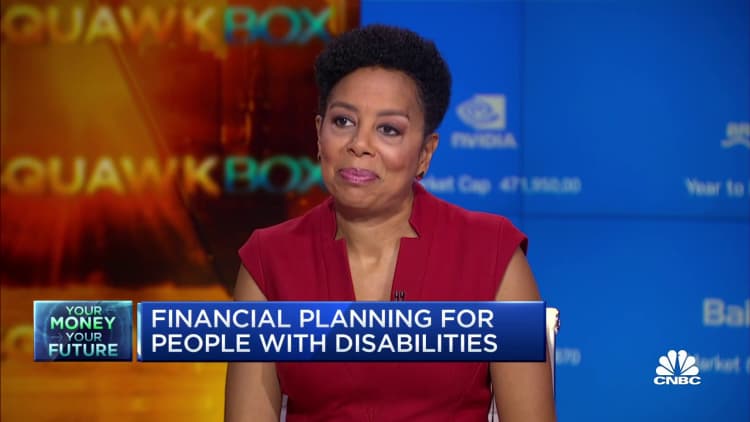
Daniel Trush was just 12 years old when a brain aneurysm rupture changed the course of his entire life.
“I went into a coma, and I was in a coma for 30 days — and I was in the hospital and rehab for a total of 341 days,” said Daniel, who is now 38 and lives in New York. But, he quipped with a smile, “who’s counting?”
It was during his rehabilitation that Daniel and his family found a connection with others through music. Now he is the co-founder and president of Daniel’s Music Foundation, a nonprofit that provides free music programs for people with disabilities.
Daniel’s parents, Ken and Nancy, now in their 60s, have helped him reach his goals in part by planning for his financial security using a business mindset.
“I’m used to business plans, and so I converted a business plan to a personal plan,” Ken Trush said. “This is what we have coming in. This is what we want to do. Where’s the surplus? How much do we have to save?”
About 61 million adults in the U.S., or 1 in 4, live with a disability, according to the Centers for Disease Control and Prevention. A new study by Fidelity found more than half of caregivers of loved ones with disabilities had little time to prepare before assuming responsibility.
Daniel Trush, president of Daniel’s Music Foundation in New York.
Daniel’s Music Foundation
Yet about one-third of those surveyed said it was easier than expected to create a plan for current and future expenses and understand government benefits that are available.
Access all available benefits
One of the most critical steps in providing for a child or beneficiary with disabilities is applying for Supplemental Security Income or Social Security Disability Insurance, said James Lange, the president of Lange Financial Group in Pittsburgh. You can apply online on the Social Security Administration’s website.
Also, “maximize your employee benefits and start looking at what government benefits are available to you in your city, in your county, at the state level and at the federal level,” said Jessica Tuman, vice president of the Voya Cares Center of Excellence at Voya Financial in Atlanta.
Benefits may include health-care concierge services that focus on helping families care for loved ones with complex, chronic or ongoing care needs, she said. Your company’s programs may also provide legal services to help with medical authorization forms for your child, your will, powers of attorney and other estate planning documents.
Set up targeted savings
Boonchai Wedmakawand | Moment | Getty Images
Setting up targeted savings is also vital to secure a disabled person’s financial future, experts say.
Also, “if you were saving in a regular 529 plan and your child became disabled prior to 26 you can transfer those funds into an ABLE account,” said financial advisor Charlie Massimo, a senior vice president at Wealth Enhancement Group in Deer Park, New York. “There are certain restrictions and limitations you do need to follow, however.”
One of the best ways to get support is finding not-for-profit organizations for your particular type of disability.
Jessica Tuman
vice president of the Voya Cares Center of Excellence at Voya Financial
Optimizing Roth individual retirement account conversions also can be “advantageous for you, but critical for your child,” Lange said. If a disabled child or beneficiary inherits a traditional or Roth IRA or 401(k), they can stretch distributions over their lifetime, instead of having to withdraw money within 10 years like most beneficiaries.
If a disabled child inherits a regular IRA, for example, they could stretch that over their lifetime, but would have to pay taxes on the annual distributions, he said. Yet converting the inherited IRA to an inherited Roth IRA — and paying taxes on the conversion — would allow the disabled beneficiary to get tax-free distributions for life.
Truman recommends that families looking for financial or legal advice in regard to setting up a special needs trust or other aspects of estate planning go to The Academy of Special Needs Planners and the Special Needs Alliance to find experts.
Find a community of support
Dougal Waters | Digitalvision | Getty Images
Connecting with other families with disabled loved ones is another way to find out about financial and other resources that may be available in your area.
“One of the best ways to get support is finding not-for-profit organizations for your particular type of disability,” Tuman said. Look at groups such as the National Down Syndrome Association, Autism Society and Easterseals, which may offer specialized programs that offer respite care and/or support programs for parents, she said.
Coming together for music and fun can also lead to important financial conversations — and connections. “We find that a lot of the parents’ caregivers come together because there’s a commonality,” said Ken Trush. “They feel comfortable.
“Sometimes, outside people do not understand what they’re going through.”
September is Brain Aneurysm Awareness Month. Daniel Trush and Sharon Epperson are brain aneurysm survivors. You can learn more about the risk factors and treatment for this disease on the Brain Aneurysm Foundation’s website.
 EU News Digest Latest News & Updates
EU News Digest Latest News & Updates



